 Last additions - Yasu 野洲市 Last additions - Yasu 野洲市 |
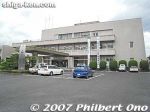
Apr 15, 2014
|
|

Yasu City HallApr 15, 2014
|
|

Buses going back to Yasu Station run only once an hour. The bus stop to go back to Yasu Station is up the slope on the other side of the road where you got off. You can ask the museum about the bus times to go back.Apr 14, 2014
|
|

Apr 14, 2014
|
|

Apr 14, 2014
|
|
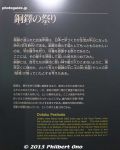
Apr 14, 2014
|
|
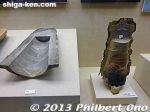
Apr 14, 2014
|
|
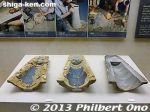
Apr 14, 2014
|
|
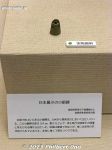
Japan's smallest dotaku. 3.4 cm high.Apr 14, 2014
|
|

Apr 14, 2014
|
|
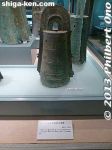
Apr 14, 2014
|
|
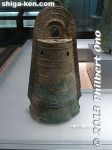
Apr 14, 2014
|
|
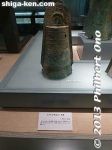
Apr 14, 2014
|
|
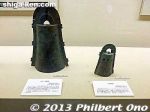
Apr 14, 2014
|
|

Apr 14, 2014
|
|
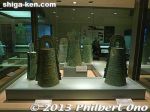
A whole bunch of other dotaku were found in the same area as late as 1962. Most of the bells displayed are replicas, but a few are genuine.Apr 14, 2014
|
|
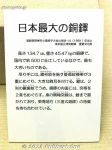
About Japan's largest dotaku bronze bell.Apr 14, 2014
|
|
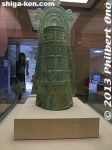
Japan's largest dotaku bronze bell on special display at Dotaku Museum in Yasu, Shiga. This bell was used as a religious ceremonial piece rather than as a real bell.Apr 14, 2014
|
|
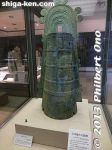
Japan's largest dotaku bronze bell is 134 cm high and dated from around 100 BC to 300 AD (Japan’s Yayoi Period).Dotaku bells in Kinki area are known for their protruding "ears," whereas dotaku found in Shizuoka (another dotaku hotbed) usually don't have ears.Apr 14, 2014
|
|
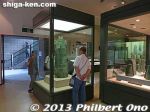
Japan's largest dotaku bronze bell on a special homecoming display at Dotaku Museum in Yasu, Shiga.Apr 14, 2014
|
|
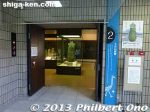
Apr 14, 2014
|
|

Museum entrance with a sign indicating the Homecoming Exhibition for Japan’s Largest Bronze Bell to mark the museum's 25th anniversary.Apr 14, 2014
|
|
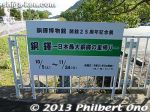
Sign for the homecoming exhibition of Japan's largest dotaku bronze bell during autumn 2013.Apr 14, 2014
|
|
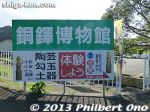
Dotaku Museum sign. The museum is open 9 am to 5 pm, closed Mon. (open if national holiday). From JR Yasu Station’s South exit (Minami-guchi), take a bus going to Karyoku Koen (花緑公園) or Murata Seisakusho (via Nishi Gate 西ゲート経由 村田Get off at Dotaku Hakubutsukan-mae (銅鐸博物館前). Bus ride is only a few minutes. From bus stop, cross the road to get to the museum.Apr 14, 2014
|
|

During Oct. 5 to Nov. 24, 2013, for the first time since its discovery in Yasu in 1881, Japan's largest bronze bell was exhibited at the Dotaku Bronze Bell Museum. Buses to the museum ran from Yasu Station.Apr 14, 2014
|
|
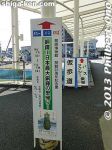
Dotaku means bronze bell. Yasu is the site of the discovery of Japan's largest ancient bronze bells. The Dotaku Bronze Bell Museum (Dotaku Hakubutsukan) explains the history and discovery of Yasu's bronze bells.Apr 14, 2014
|
|

My YouTube video of the Ayame mikoshi girls at Hyozu Matsuri in 2010.Jun 06, 2010
|
|

My YouTube video of Hyozu Matsuri in 2010.Jun 06, 2010
|
|

After the festival is over, the path is deserted. I had to take a taxi back to Yasu Station. No buses running.May 30, 2010
|
|

The mikoshi head home from Hyozu Taisha. That's Mt. Mikami in the background.May 30, 2010
|
|

He thanked the girls and asked them to help clean up. He also gave away the iris flowers.May 30, 2010
|
|

May 30, 2010
|
|

May 30, 2010
|
|
|

May 30, 2010
|
|

May 30, 2010
|
|

Approaching Hyozu Taisha.May 30, 2010
|
|

May 30, 2010
|
|

May 30, 2010
|
|

May 30, 2010
|
|

May 30, 2010
|
|

May 30, 2010
|
|

May 30, 2010
|
|

May 30, 2010
|
|

May 30, 2010
|
|

May 30, 2010
|
|

May 30, 2010
|
|

May 30, 2010
|
|

May 30, 2010
|
|

May 30, 2010
|
|

May 30, 2010
|
|

May 30, 2010
|
|

Ayame girls at Hyozu Matsuri in Yasu.May 30, 2010
|
|

May 30, 2010
|
|

May 30, 2010
|
|

The Ayame taiko girls turn back for the last time and head for the shrine.May 30, 2010
|
|

May 30, 2010
|
|

May 30, 2010
|
|

May 30, 2010
|
|

May 30, 2010
|
|

May 30, 2010
|
|

May 30, 2010
|
|

May 30, 2010
|
|

May 30, 2010
|
|

May 30, 2010
|
|

May 30, 2010
|
|

May 30, 2010
|
|

May 30, 2010
|
|

May 30, 2010
|
|
|

May 30, 2010
|
|

May 30, 2010
|
|

May 30, 2010
|
|

May 30, 2010
|
|

May 30, 2010
|
|

May 30, 2010
|
|

May 30, 2010
|
|

May 30, 2010
|
|

May 30, 2010
|
|

May 30, 2010
|
|

May 30, 2010
|
|

May 30, 2010
|
|

May 30, 2010
|
|

May 30, 2010
|
|

They are so photogenic.May 30, 2010
|
|

May 30, 2010
|
|

May 30, 2010
|
|

May 30, 2010
|
|

May 30, 2010
|
|

May 30, 2010
|
|

May 30, 2010
|
|

May 30, 2010
|
|

May 30, 2010
|
|

May 30, 2010
|
|

May 30, 2010
|
|

May 30, 2010
|
|

May 30, 2010
|
|

Ayame taiko girls.May 30, 2010
|
|

May 30, 2010
|
|

May 30, 2010
|
|

May 30, 2010
|
|

May 30, 2010
|
|

May 30, 2010
|
|

May 30, 2010
|
|

Shrine maidens.May 30, 2010
|
|

May 30, 2010
|
|

The children's mikoshi start to leave Hyozu Shrine as the festival winds down.May 30, 2010
|
|

Meanwhile a Shinto ceremony is held in the shrine hall.May 30, 2010
|
|

May 30, 2010
|
|

Festival crowd head for the shrine to pray.May 30, 2010
|
|

May 30, 2010
|
|

A priest blesses each children's mikoshi.May 30, 2010
|
|

The children's mikoshi are parked along this path in front of the shrine.May 30, 2010
|
|

May 30, 2010
|
|

May 30, 2010
|
|

May 30, 2010
|
|

May 30, 2010
|
|

May 30, 2010
|
|

May 30, 2010
|
|

Hyozu Matsuri Festival 兵主祭May 30, 2010
|
|

May 30, 2010
|
|

May 30, 2010
|
|

May 30, 2010
|
|

May 30, 2010
|
|

May 30, 2010
|
|

May 30, 2010
|
|

May 30, 2010
|
|

May 30, 2010
|
|

The Ayame mikoshi girls head for the shrine.May 30, 2010
|
|

May 30, 2010
|
|

Ayame mikoshi girls at Hyozu Matsuri Festival, Shiga. 兵主祭May 30, 2010
|
|

May 30, 2010
|
|

May 30, 2010
|
|

May 30, 2010
|
|

May 30, 2010
|
|

May 30, 2010
|
|

May 30, 2010
|
|

May 30, 2010
|
|

May 30, 2010
|
|

May 30, 2010
|
|

May 30, 2010
|
|

May 30, 2010
|
|

May 30, 2010
|
|

May 30, 2010
|
|

May 30, 2010
|
|

May 30, 2010
|
|

May 30, 2010
|
|

May 30, 2010
|
|

May 30, 2010
|
|

May 30, 2010
|
|

May 30, 2010
|
|

May 30, 2010
|
|

May 30, 2010
|
|

I often see foreigners participating in Shiga festivals.May 30, 2010
|
|

May 30, 2010
|
|

Nice to see a few foreigners too. Local English teachers perhaps.May 30, 2010
|
|

The Ayame girls return.May 30, 2010
|
|

May 30, 2010
|
|

May 30, 2010
|
|

The big Omiya mikoshi.May 30, 2010
|
|

May 30, 2010
|
|

May 30, 2010
|
|

May 30, 2010
|
|

Almost got run over by this one.May 30, 2010
|
|

May 30, 2010
|
|

May 30, 2010
|
|

May 30, 2010
|
|

May 30, 2010
|
|

May 30, 2010
|
|

May 30, 2010
|
|

May 30, 2010
|
|

May 30, 2010
|
|

May 30, 2010
|
|

May 30, 2010
|
|

May 30, 2010
|
|

May 30, 2010
|
|

May 30, 2010
|
|

The drummer really has to move quickly with the rest of the boys as they move unpredictably.May 30, 2010
|
|

May 30, 2010
|
|

May 30, 2010
|
|

The lost mikoshi.May 30, 2010
|
|

May 30, 2010
|
|

All that gravel can make it quite dusty.May 30, 2010
|
|

May 30, 2010
|
|

May 30, 2010
|
|

May 30, 2010
|
|

May 30, 2010
|
|

May 30, 2010
|
|

They come one after another, big and small.May 30, 2010
|
|

May 30, 2010
|
|

May 30, 2010
|
|
|

May 30, 2010
|
|

May 30, 2010
|
|

May 30, 2010
|
|

May 30, 2010
|
|

May 30, 2010
|
|

May 30, 2010
|
|

May 30, 2010
|
|

May 30, 2010
|
|

May 30, 2010
|
|

May 30, 2010
|
|

May 30, 2010
|
|

May 30, 2010
|
|

A unique thing about this festival is that the mikoshi rider pulls out and raises the mikoshi's top ornament (usually a phoenix). 鵜の息抜きMay 30, 2010
|
|

Looking toward Hyozu Taisha Shrine.May 30, 2010
|
|

May 30, 2010
|
|

May 30, 2010
|
|

May 30, 2010
|
|

May 30, 2010
|
|

May 30, 2010
|
|

One feature of this festival is that someone rides on the mikoshi and detaches and raised the phoenix ornament at the top of the mikoshi.May 30, 2010
|
|

May 30, 2010
|
|

At this end of the pine tree path, there is the Taikobashi Bridge and the red torii. This is where the crowd is concentrated to see the mikoshi being raised and the phoenix atop the mikoshi pulled out and raised by the mikoshi rider..May 30, 2010
|
|

One mikoshi was missing. Maybe it was lost.May 30, 2010
|
|

May 30, 2010
|
|

May 30, 2010
|
|

May 30, 2010
|
|

May 30, 2010
|
|

May 30, 2010
|
|

May 30, 2010
|
|

They shout "Choitosa!" while carrying the mikoshi. チョイトサMay 30, 2010
|
|

Many of the mikoshi are for children. The mikoshi come from smaller shrines in the area related to Hyozu Taisha.May 30, 2010
|
|

May 30, 2010
|
|

There are several large mikoshi carried by men. All the mikoshi and taiko drums have a name.May 30, 2010
|
|

May 30, 2010
|
|

A set routine is lowering and raising the mikoshi.May 30, 2010
|
|

May 30, 2010
|
|

May 30, 2010
|
|

May 30, 2010
|
|

May 30, 2010
|
|

May 30, 2010
|
|

They leave here and proceed along the pine tree path to the first torii. Then they will come back here and go back and forth a few times during the festival.May 30, 2010
|
|

They crossed over the Taikobashi Bridge. あやめ神輿May 30, 2010
|
|

May 30, 2010
|
|

May 30, 2010
|
|

May 30, 2010
|
|

After the taiko drum, a second group of girls start carrying the Ayame mikoshi. May 30, 2010
|
|

It was a beautiful festival day on May 5, 2010. The Ayame girls wore colorful happi coats which really added color to the festival.May 30, 2010
|
|
|

At the festival start time, the Ayame girls start carrying the taiko drum and mikoshi from this gate.May 30, 2010
|
|

May 30, 2010
|
|

May 30, 2010
|
|

Ayame girls at Hyozu Matsuri.May 30, 2010
|
|

A Shinto ceremony is held at the shrine in the morning. Then by noon or so, over 30 portable shrines and taiko drums gather here on this path for the annual Hyozu Matsuri on May 5.May 30, 2010
|
|

Ayame girls rehearsing their festival call.May 30, 2010
|
|

May 30, 2010
|
|

"Ayame" means iris flower, in reference to women. Out of the 30+ portable shrines (mikoshi) and taiko drums to be paraded during the festival, two of them, called Ayame, are carried only by women. These women will carry the Ayame mikoshi and taiMay 30, 2010
|
|

When I arrived, the Ayame girls were rehearsing their routine for the festival in front of this red Romon Gate. This gate was said to have been donated by Shogun Ashikaga Takauji in the 14th century. 楼門May 30, 2010
|
|

At the end of the pine tree path, the second torii is red, right after the Taikobashi Bridge.May 30, 2010
|
|

The Hyozu Matsuri is held at Hyozu Taisha Shrine during May 3-6, but the 5th is the climax with the mikoshi parade. This is the shrine's first torii. This is at the front end of a 300-meter pine tree-lined path. Infrequent buses go to the shrine from Yasu Station (North exit). So infrequent that you might need to take a taxi. 一の鳥居May 30, 2010
|
|

When I visited this shrine before, I wondered what these stone markers were for. Now I know. They have the name of a portable shrine, indicating the place where the respective portable shrines can be parked along this path during the festival.May 30, 2010
|
|
|
|